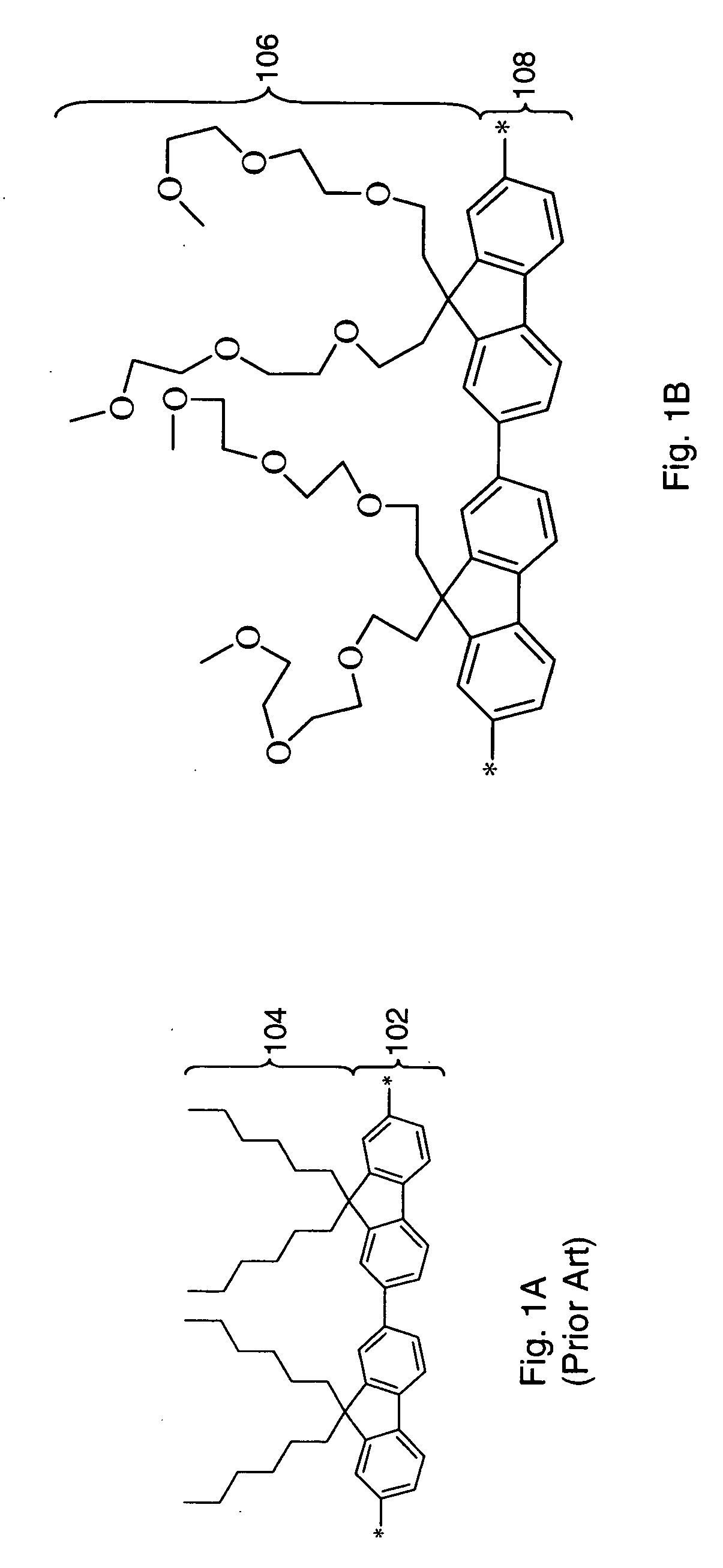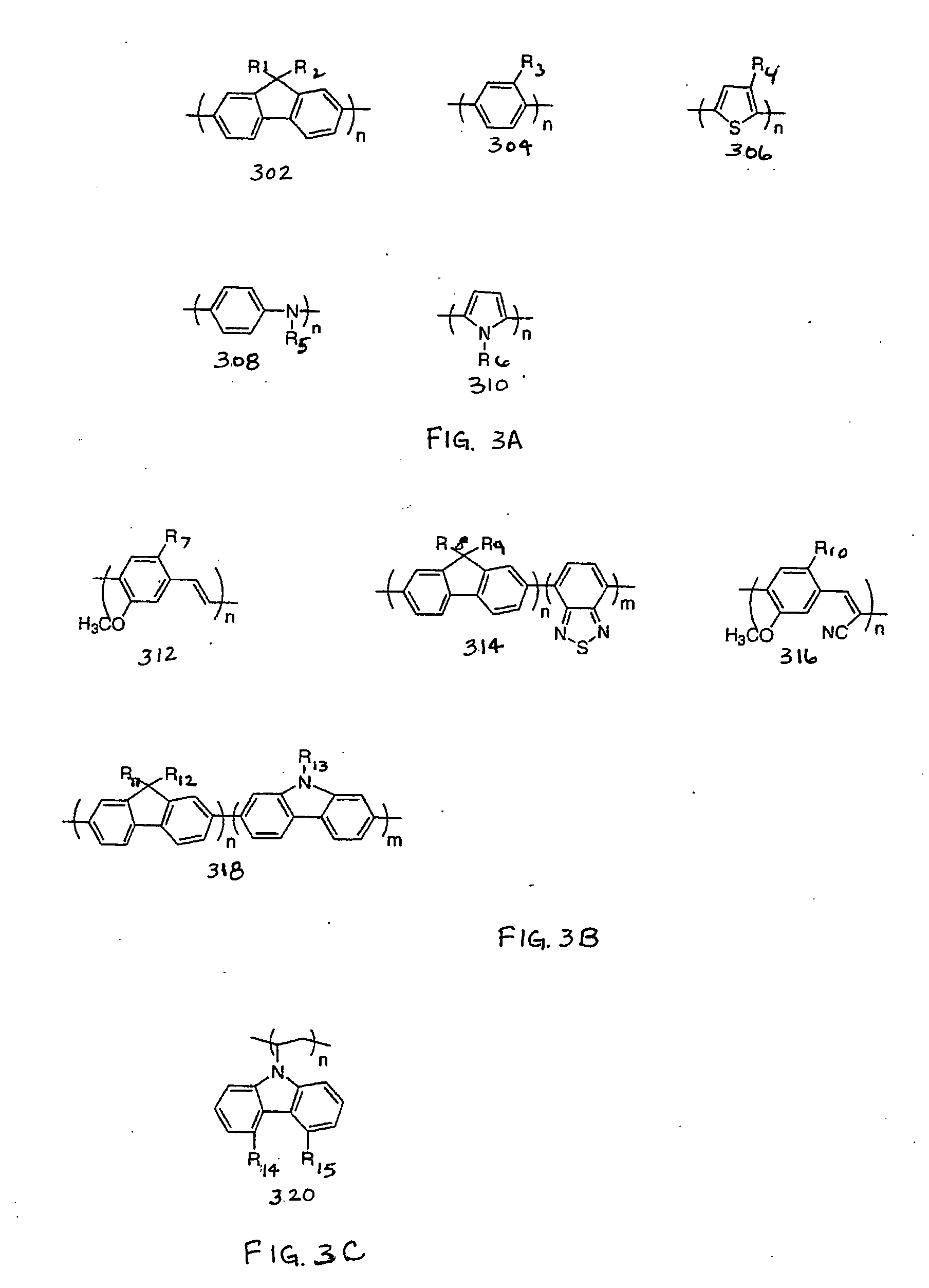Carbon nanotube polymer composition and devices
a technology of carbon nanotubes and polymer compounds, applied in the direction of discharge tubes luminescnet screens, non-metal conductors, applications, etc., can solve the problems of limited materials available, solubility of swnt in other conductive polymer systems,
- Summary
- Abstract
- Description
- Claims
- Application Information
AI Technical Summary
Problems solved by technology
Method used
Image
Examples
example 1
Synthesis of PFO-Poly(2,7-9,9 (di(oxy-2,5,8-trioxadecane))fluorene)
[0059]
Synthesis of 10-Tosyloxy-2,5,8-trioxadecane
[0060] Triethlyene glycol monomethylether (10 g, 61 mmol) was dissolved in THF (50 mL) and cooled to approximately 0° C. in an ice bath. A solution of KOH (5.6 g, 100 mmol) in 10 mL water was slowly added to the mixture, and then a solution of TsCl (9.5 g, 50 mmol) in 20 mL THF was added drop-wise over 20 min. with vigorous stirring. After stirring overnight in an ice bath, the mixture was poured into distilled water (200 mL) and extracted with CH2Cl2 (2×100 mL). The combined organic solutions were washed with saturated NaHCO3 solution (2×100 mL), distilled water (2×100 mL), dried over MgSO4, and concentrated under reduced pressure to give 15.7 g as a clear colorless oil9 in 99% yield. 1H NMR (300 MHz, CDCl3), 2.3 (s, 3H), 3.22 (s, 3H), 3.28-3.70 (m, 10H), 4.04 (t, 2H), 7.24 (d, 2H), 7.68 (d, 2H).
Synthesis of 2,7-Dibromo-9,9 (di(oxy-2,5,8-trioxadecane))fluorene
[006...
example 2
Preparation of a SWNT / PFO
[0063] The as-prepared (AP) grade SWNT tube was purchased from CarboLex® and used without further purification. The AP grade SWNT contains 60% of pure carbon nanotube and 40% of amorphous carbon and catalysts. The dispersion of SWNT is achieved by sonication of the mixture of SWNT, polymer and solution using a Branson 1210 sonicator. The solutions were then left without vibration for a week to sediment. The top part of the solutions was studied and used to cast films.
example 3
Preparation of an OLED with Carbon Nanotube in Light Emitting Layer
[0064] The resistance of the ITO glass used herein is 13 Ω / □. The ITO coated glass was successively cleaned in saturated KOH / Isopropanol solution, followed by three 20-minute sonication cleaning in acetone, isopropanol and methanol and final oxygen plasma treatment. The conductive polymers were spin coated in a class 100 clean room. The PEDOT / PSS aqueous solution was purchased from Aldrich and filtered through a 0.45 μm syringe filter. The PEDOT / PSS layer was spin coated at 1500 rpm, resulting in a 120 nm film. The conductive polymer solutions were filtered with 0.45 μm syringe filter. The generic composition to formulate SWNT / conductive polymer composite is 3.3 g AP grade SWNT / 100 g conductive polymer / 10 L solvent. (3.3 g of AP grade SWNT contains 2 g of pure SWNT). The PFO (or SWNT composite) layer was spin coated at 1000 rpm on the top of PEDOT / PSS layer, resulting in a 40 nm film. 50 nm of aluminum cathode was t...
PUM
| Property | Measurement | Unit |
|---|---|---|
| Composition | aaaaa | aaaaa |
| Electrical conductor | aaaaa | aaaaa |
| Transport properties | aaaaa | aaaaa |
Abstract
Description
Claims
Application Information
 Login to View More
Login to View More - R&D
- Intellectual Property
- Life Sciences
- Materials
- Tech Scout
- Unparalleled Data Quality
- Higher Quality Content
- 60% Fewer Hallucinations
Browse by: Latest US Patents, China's latest patents, Technical Efficacy Thesaurus, Application Domain, Technology Topic, Popular Technical Reports.
© 2025 PatSnap. All rights reserved.Legal|Privacy policy|Modern Slavery Act Transparency Statement|Sitemap|About US| Contact US: help@patsnap.com



